|
|
|
Sort Order |
|
|
|
Items / Page
|
|
|
|
|
|
|
| Srl | Item |
| 1 |
ID:
117019


|
|
|
|
|
| Publication |
2012.
|
| Summary/Abstract |
In 2011, the Uppsala Conflict Data Program (UCDP) recorded 37 armed conflicts with a minimum of 25 battle-related deaths. This significant increase from the 31 conflicts recorded in 2010 was primarily driven by an increase in conflicts on the African continent, and is only in part due to events tied to the Arab Spring which mostly led to other forms of violence than conventional armed conflict. The number of active conflicts still remains at a relatively low level compared to the peak years in the early 1990s, when more than 50 conflicts were active. The number of wars - conflicts leading to 1,000 or more battle-related deaths - increased to six; however, it is a considerably lower number than during the peak years of the early 1990s. For the second consecutive year, Afghanistan claimed the highest number of fatalities. Five armed conflicts listed for 2010 were not active in 2011, but during the year three new conflicts erupted - Libya, South Sudan and Sudan (Abyei) - and six conflicts already registered were restarted. Only one peace agreement was concluded during the year. Thus, the trend with low numbers of peace accords which started in 2009 continues.
|
|
|
|
|
|
|
|
|
|
|
|
|
|
|
|
| 2 |
ID:
117015
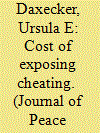

|
|
|
|
|
| Publication |
2012.
|
| Summary/Abstract |
This article investigates the relationship between international election observation, election fraud, and post-election violence. While international electoral missions could in principle mitigate the potential for violence by deterring election fraud, the ability of international observers to detect manipulation may in fact induce violent uprisings. Serious irregularities documented by international observers provide credible information on election quality, which draws attention to election outcomes and alleviates coordination problems faced by opposition parties and society. When elections are manipulated to deny citizens an opportunity for peaceful contestation and international observers publicize such manipulation, violent interactions between incumbents, opposition parties, and citizens can ensue. Consequently, the author expects that fraudulent elections monitored by international organizations will have an increased potential for subsequent violence. This expectation is evaluated empirically in an analysis of post-election conflict events for African elections in the 1997-2009 period. Using original data on electoral manipulation and reputable international election observation missions, findings show that the presence of election fraud and international observers increases the likelihood of post-election violence. Matching methods are employed to account for the possibility that international observers' decisions to monitor elections are endogenous to the occurrence of violence in the electoral process. Results for matched samples confirm the findings in the unmatched sample. A variety of robustness tests show that the results are not influenced by the operationalization of independent variables and influential observations.
|
|
|
|
|
|
|
|
|
|
|
|
|
|
|
|
| 3 |
ID:
117020
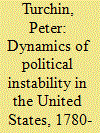

|
|
|
|
|
| Publication |
2012.
|
| Summary/Abstract |
This article describes and analyses a database on the dynamics of sociopolitical instability in the United States between 1780 and 2010. The database was constructed by digitizing data collected by previous researchers, supplemented by systematic searches of electronic media archives. It includes 1,590 political violence events such as riots, lynchings, and terrorism. Incidence of political violence fluctuated dramatically over the 230 years covered by the database, following a complex dynamical pattern. Spectral analysis detected two main oscillatory modes. The first is a very long-term - secular - cycle, taking the form of an instability wave during the second half of the 19th century, bracketed by two peaceful periods (the first quarter of the 19th century and the middle decades of the 20th century, respectively). The second is a 50-year oscillation superimposed on the secular cycle, with peaks around 1870, 1920, and 1970. The pattern of two periodicities superimposed on each other is characteristic of the dynamics of political instability in many historical societies, such as ancient Rome and medieval and early-modern England, France, and Russia. A possible explanation of this pattern, discussed in the article, is offered by the structural-demographic theory, which postulates that labor oversupply leads to falling living standards and elite overproduction, and those, in turn, cause a wave of prolonged and intense sociopolitical instability.
|
|
|
|
|
|
|
|
|
|
|
|
|
|
|
|
| 4 |
ID:
117022
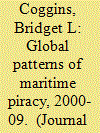

|
|
|
|
|
| Summary/Abstract |
This article introduces the Maritime Piracy Data (MPD), a dataset dedicated to understanding the nature, dynamics, and causes of contemporary piracy and armed robbery against ships. Data on maritime piracy are presented in two formats: an event set and an annual, country-level set. The event data track every maritime piracy attack reported to the International Maritime Bureau's Piracy Reporting Center (IMB/PRC) for a total of 3,413 events between 2000 and 2009. Entries provide event details including date, geo-coded location, attacker nationality, victim nationality, success, vessel type, violence level, loot taken, and/or ransom demanded. The annual data count the number of piracy events emanating from the world's 147 coastal countries over the same decade for a total of 1,470 observations. Entries include country-level information regarding the maritime sector including coastal shipping traffic, coastline length, seaports, distances to major sea lane chokepoints, and merchant marine size. The article describes the main features of the data, provides descriptive statistics, and briefly illustrates their potential utility for research. The MPD has potential utility for scholars examining non-traditional threats generated by non-state actors; for those studying the potential relationships between governance and conflict on land and piracy at sea; and for individuals engaged in policy-relevant analyses evaluating the effectiveness and efficiency of counter-piracy strategies and tactics.
|
|
|
|
|
|
|
|
|
|
|
|
|
|
|
|
| 5 |
ID:
117016


|
|
|
|
|
| Publication |
2012.
|
| Summary/Abstract |
Leadership turnover may produce significant foreign policy changes when leaders differ from their predecessors in their preferences over the resort to war and when they cannot commit to implement inherited policies. How, then, does the expected behavior of an incumbent leader's successor affect crisis bargaining in the present? I analyze a leader-centric model of crisis bargaining in which (a) the distributive outcomes of crises affect political survival, (b) leadership turnover implies the accession of a new leader with potentially different preferences, and (c) successors can renegotiate inherited settlements. In equilibrium, the sensitivity of an incumbent's political survival to making concessions interacts with the resolve of the successor to affect both the terms of settlement and the occurrence of war. First, political survival incentives can lead an incumbent to demand more than her adversary is willing to concede, provoking war when the successor is of similar resolve. Second, when a politically sensitive incumbent will be followed by a resolute successor, her adversary may grant otherwise unnecessary concessions to bolster the relatively irresolute incumbent in office. Finally, when a politically sensitive incumbent will be followed by an irresolute successor, her adversary may attack in order to depose the incumbent, hastening her replacement to secure better bargains in the future. Predictions about the present balance of resolve and leaders' survival incentives may thus be fundamentally altered in light of the future balance of resolve.
|
|
|
|
|
|
|
|
|
|
|
|
|
|
|
|
| 6 |
ID:
117018


|
|
|
|
|
| Publication |
2012.
|
| Summary/Abstract |
More than 200 years after its first publication, the Malthusian thesis is still much debated, albeit in a modified form. Rather than predicting a global catastrophe, most neo-Malthusians stress the local character of the relationship between population pressure, natural resource scarcity, and conflict as well as its dependency on the socio-political and economic context. This softened version of Malthus's thesis has received little empirical support in cross-country studies. In contrast, a number of subnational analyses have provided some evidence for local conditional Malthusian catastrophes, although 'catastrophe' is a big word since these studies have largely focused on low-intensity violence. This article adds to the small body of subnational studies, but focuses on a high-intensity conflict - the Rwandan genocide. In particular, it provides a meso-level analysis of the relation between population pressure and the intensity of violence measured by the death toll among the Tutsi across 1,294 small administrative units. The results indicate that the death toll was significantly higher in localities with both high population density and little opportunity for young men to acquire land. This finding can be interpreted as support for the neo-Malthusian thesis. On the other hand, it is possible that another mechanism operated - in densely populated areas, it may have been relatively easy for the elite to mobilize the population, because of dependency relations through the land and labor market. Alternatively, in densely populated areas, there may have been more lootable assets, and the violence may have been opportunistic rather than driven by need or by fear.
|
|
|
|
|
|
|
|
|
|
|
|
|
|
|
|
| 7 |
ID:
117021
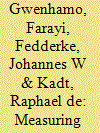

|
|
|
|
|
| Publication |
2012.
|
| Summary/Abstract |
This article presents a new dataset of indicators of political freedom, property rights and political instability for Zimbabwe for the period 1946 to 2005. The dataset is constructed by systematically coding the three concepts of political freedom, property rights and political instability along a multitude of dimensions. The lengthy time coverage of the dataset allows country-specific econometric analysis to evaluate generalizing propositions about the effects of political institutions on economic outcomes. The dataset also contributes to the dynamic analysis of the effects of political institutions on conflict, a contentious issue in political science. Correlations between the new measures reveal that while political instability has a strong and negative relationship with property rights, it has no significant relationship with political freedom. The finding supports the notion that political conflict is significantly higher in the in-between category of semi-democracy than at either end of the democracy scale. The validity of the dataset is supported by its strong correlations with other conceptually and operationally different measures of political institutions. The new dataset has begun to be employed in country-specific time-series studies of the link between institutions and economic outcomes. Two core results are that property rights influence the volumes of foreign direct investment (FDI) in Zimbabwe and that negative spillover effects of poor institutional environments can occur between neighbouring countries. It is feasible to extend the geographical coverage of the dataset by applying our methodological framework to other countries.
|
|
|
|
|
|
|
|
|
|
|
|
|
|
|
|
| 8 |
ID:
117017
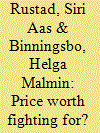

|
|
|
|
|
| Publication |
2012.
|
| Summary/Abstract |
While a number of publications show that natural resources are associated with internal armed conflict, surprisingly little research looks at how natural resources affect post-conflict peace. This article therefore investigates the relationship between natural resources and post-conflict peace by analyzing new data on natural resource conflicts. We argue that the effect of natural resources on peace depends on how a country's natural resources can constitute a motive or opportunity for armed conflict. In particular, three mechanisms may link natural resources to conflict recurrence: disagreements over natural resource distribution may motivate rebellion; using natural resources as a funding source creates an opportunity for conflict; and natural resources may aggravate existing conflict, acting either as motivation or opportunity for rebellion, but through other mechanisms than distributional claims or funding. Our data code all internal armed conflicts between 1946 and 2006 according to the presence of these resource-conflict links. We claim such mechanisms increase the risk of conflict recurrence because access to natural resources is an especially valuable prize worth fighting for. We test our hypotheses using a piecewise exponential survival model and find that, bivariately, armed conflicts with any of these resource-conflict mechanisms are more likely to resume than non-resource conflicts. A multivariate analysis distinguishing between the three mechanisms reveals that this relationship is significant only for conflicts motivated by natural resource distribution issues. These findings are important for researchers and policymakers interested in overcoming the 'curse' associated with natural resources and suggest that the way forward lies in natural resource management policies carefully designed to address the specific resource-conflict links.
|
|
|
|
|
|
|
|
|
|
|
|
|
|
|
|
|
|
|
|
|